We were having a chat about the unusual food people eat in different cultures, and Laura said, “You know some people eat every part of the fish”. I said “Yeah, we do too! The fins, the eyes, everything.” And that started a long conversation about how my culture eats goat trotters, goat tripe, oxtail stew, ox tongue, and more. And Laura goes “Gross!”
So I have to tell her that I’ve also eaten snails, live oysters, and fried worms. “Yucky!” she said. Well, one person’s weird or gross food is another person’s normal. And there’s a lot of unusual food in the world that still needs to go on my yucky food list to eat.
So I asked my friends to list the ones that they have eaten. Some of them are going on the list of gross foods that I might never eat, but some of them are going on my list of weird foods of the world to taste. Here they are! Strange and unusual foods from around the world; a bit more interesting than the list of dinner from different countries.
1. Sannakji (live octopus) Seoul, South Korea
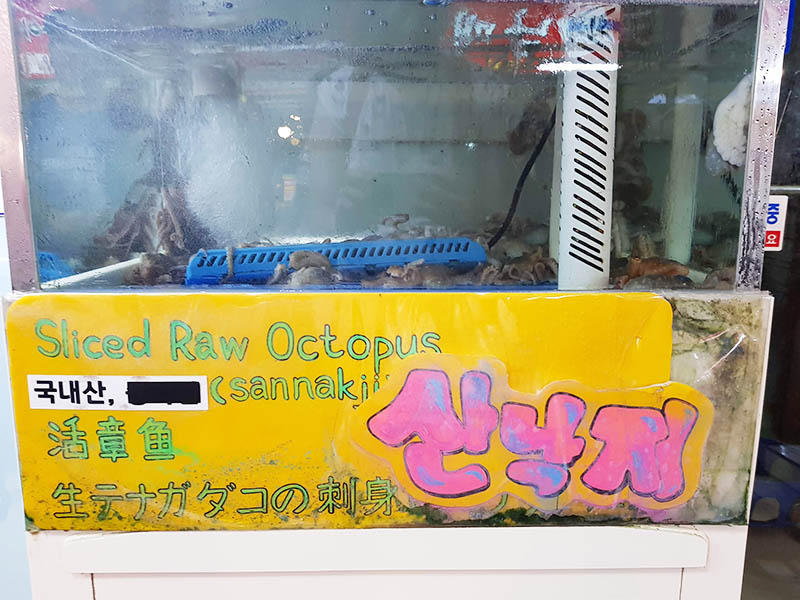
Pic by Marie from Be Marie Korea
South Korea is known for its yummy Korean BBQ and noodle dishes, compared to other Asian countries it doesn’t have that many strange or extreme dishes. Sannakji; average 10 000 krw (+- 10$) or live raw octopus is a popular dish among the locals.
The best place to try this dish is in Gwangjang market, one of the oldest wholesale markets in downtown Seoul. The market is an authentic place and still a hidden gem from tourists. 70% of all the street food vendors serve Sannakji, and prices at each stall are the same.
The dish is made from cutting up a living long arm octopus. The small pieces of the tentacles are served with sesame oil and toasted sesame seeds.
As the animal is being cut alive, the small tentacle pieces are still moving on the plate because of the complex nerve system of the octopus’, so chewing intensely is a must when eating as otherwise the still active suction cups of the animal can stick to the throat or mouth. Live octopus is best served with soju, a traditional Korean liquor.
By Marie from Be Marie Korea. Follow Marie on Facebok at BeMarieKorea
2. Tavuk Göğsü (Chicken Breast) Dessert in Turkey
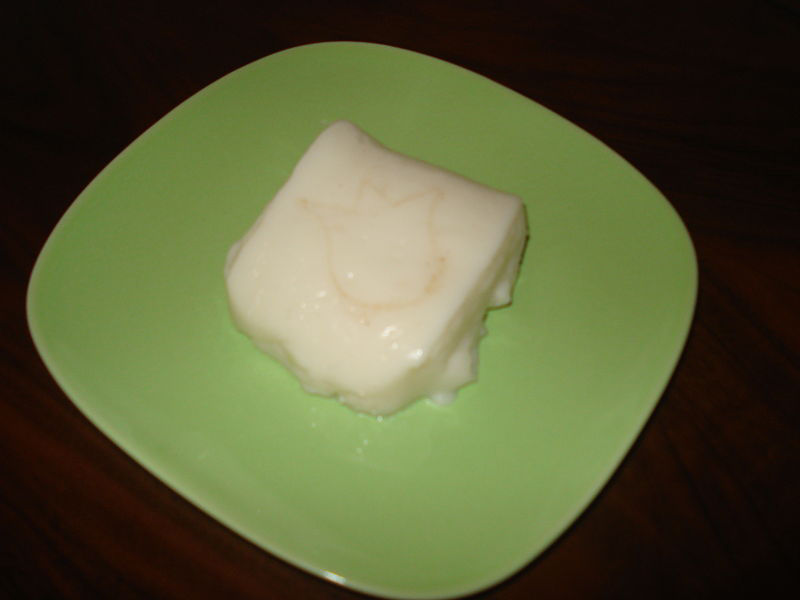
Pic by Maderibeyza Source from Wiki Commons CC BY-SA 3.0
Got a sweet tooth? If so, head over to Turkey where the desserts are fabulous. Turks are well known for classics like baklava and Turkish delight, but they also serve up some seriously strange puddings.
Perhaps the weirdest of all is Tavuk Göğsü, a silky smooth dessert made from poaching chicken breast with spices, sugar and milk. Yuk! You may be thinking, but its actually pretty good, some would say as delicious as frozen custard in Kansas.
It’s a bit like a cinnamon and vanilla white pudding and the chicken it contains is boiled so slowly that it almost entirely disintegrates, only used to give the sweet its unique consistency.
The dish was first made popular by Ottoman Sultans and is still loved by many locals and foodies today. You will find Tavuk Göğsü in many traditional Turkish restaurants and lokantas in Turkey.
Give it a go, it’s a satisfying and surprisingly tasty treat – you can’t even taste the chicken!
By Sam from Growing Up Two
Follow Sam on Facebook at GrowingUpTwo
3. Century Old Egg in Hong Kong
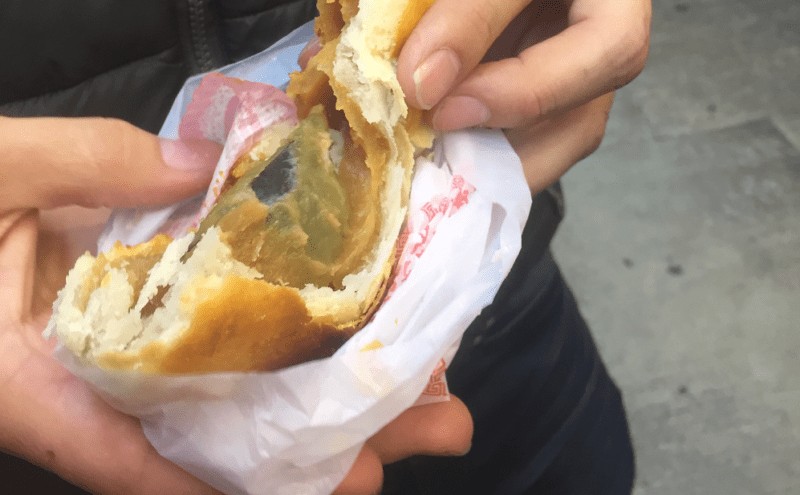
Pic by Daniel from Destinationless Travel
While I was backpacking in Hong Kong I joined a food tour. On this food tour my guide asked if I would like to try a rather strange food that she was sure I hadn’t seen before – a Century Old Egg (also referred to as a “Century Egg” or “Hundred Year Old Egg” or “Black Egg”.) A Century Egg is a duck, chicken, or quail egg that is typically preserved in a mixture of salt, black tea, lime, and ash for between 5 weeks to 5 months! This process turns the egg black, You can find Century Eggs throughout both Hong Kong and mainland China and they are very popular at street stalls and markets especially around celebration times such as Chinese New Year. The Century Egg I tried in Hong Kong was a dessert-style Century Egg that had been covered in a custard and pastry! Although the look and texture really put me off, the flavor wasn’t all that bad. But in all honesty, I’ll probably stick to ice-cream the next time I have a sweet tooth!
By Daniel from Destinationless Travel
See Daniel’s amazing pics on Instagram at Destinationless Travel
4. Chou Doufu or Stinky Tofu, China
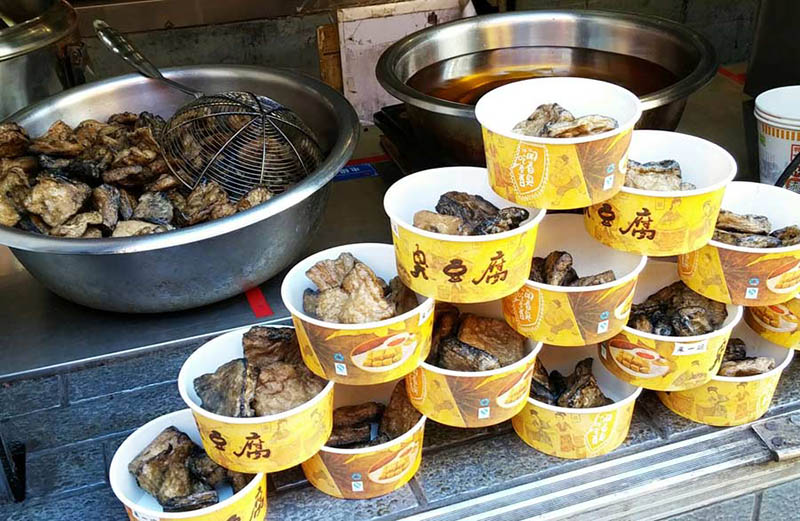
Pic by Evelyne from CulturEatz
After walking for hours with my new Chinese friend in Beijing, he suggested we should get a snack. How about a traditional stinky tofu snack? Umm, OK I guess. Chou doufu, or fried fermented tofu, is commonly sold as street food. Rarely will you find it in a restaurant.
Regular tofu is placed in a brine of fermented ingredients (milk, vegetable, meat and or fish) and bathed from a few days to a few months. Today’s street vendors mostly only use mass-produced chou doufu which has only been brined for a few days, therefore it is not very stinky.
In fact, I was surprised that my fried stinky tofu was not as bad as I had expected it. It was even petty good. It had a bit of a sour taste to it but it did not taste like it had gone bad. The black color caught me by surprise. I also saw pale fried ones. And chou doufu can also be served plain, added to stews, spiced up, or steamed.
Would you be up to trying stinky tofu? If you want to try the real stuff, look for a vendor which advertises a homemade version or ask how many weeks the tofu had been brined. The real stuff will smell like old wet sox. As the locals say, the smellier the chou doufu, the tastier it will be!
By Evelyne from CulturEatz
Follow Evelyne on Facebook at CulturEatz
5. Casu Marzu, Sardinia, Germany
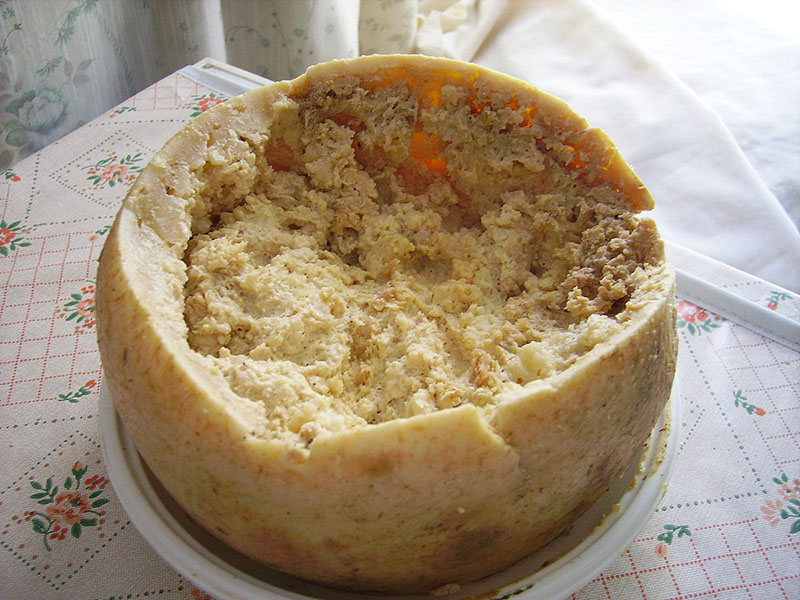
Pic by Shardan Source from Wiki Commons CC BY-2.5
While on a family holiday in Sardinia, we were approached by a camera team, looking slightly awkward at best. With wine and cheese in hand, they greeted us and explained they were from a German TV station and wanted us to try some wine and cheese, how could we say no? We nibbled away on the odd, but surprisingly tasty cheese, before the German presenter explained that they were representing a German science channel and the cheese was actually illegal all over the world.
Needless to say, we started looking a little anxious, but that was nothing until they brought the large cheese ball over and opened it up. Peering inside, we saw live maggots moving around like something out of a horror film!
They then explained that Casu Marzu could only be found in Sardinia, produced from sheep milk cheese, however, eggs are laid inside, before the maggots hatch and eat through the cheese, with their acid making the cheese very soft. It was outlawed by the European Union, but could still be found on the black market, not exactly a law we expected to be breaking while on a family holiday!
While we were left feeling a little queasy, that was probably more psychological and the reality is the cheese actually tasted quite good.
Read the list of 100 things to do before you die by Tom from Spaghetti Traveller
Follow Tom on Twitter at Spaghetti Traveller
6. Grasshopper in Mexico
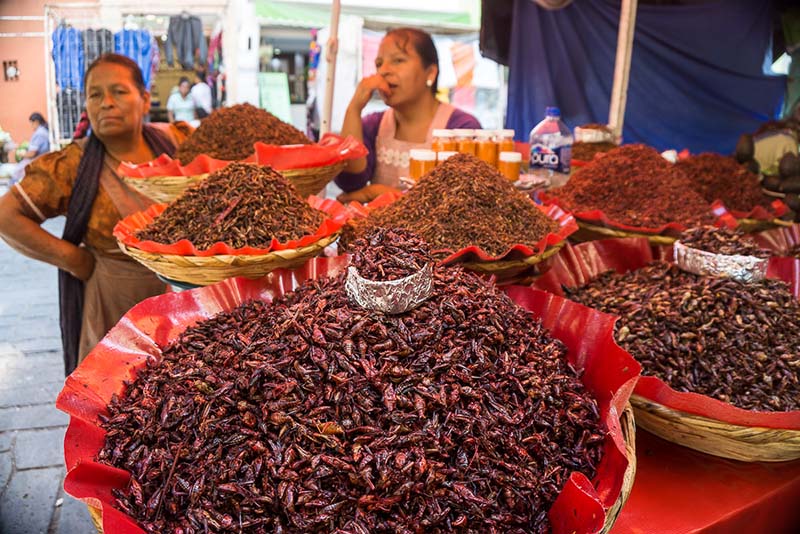
Pic by Jess from Unearth the Voyage
One of the strangest things I have ever eaten before is a grasshopper. For the longest time, I was pretty against eating any type of bug because let’s be honest- it’s kinda gross. After having a discussion with friends in Mexico about how you find the grasshopper legs between your teeth later that day I was even more turned off to the idea of trying one. Although, it was super hard to get away with not trying just one on our trip to Oaxaca City in Mexico. Grasshoppers (chapulines) are found EVERYWHERE in this town- and the locals actually eat them every day as a snack! They love to put them in guacamole or fry them up with a little chili seasoning and just snack on them. Just head to any of the markets or get some guacamole con chapulines at a restaurant if you’d like to try them. Finally, my time had come to try one and believe it or not, I actually ate like 5 after the first one because they actually tasted good! Besides being environmentally friendly to eat bugs as a protein source, in Mexico, one of the main reasons grasshoppers are found everywhere is because farmers catch and sell the grasshoppers instead of using pesticides to get rid of them on their plants! People enjoy them as a snack, and it helps the produce in Mexico stay pesticide free! If looking for something fun and exciting to do in Mexico, trying grasshoppers is an experience and a great story to tell later on!
By Jess from Unearth the Voyage
Follow Jess on Facebook at Unearth the Voyage
7. Sea Pineapple in South Korea
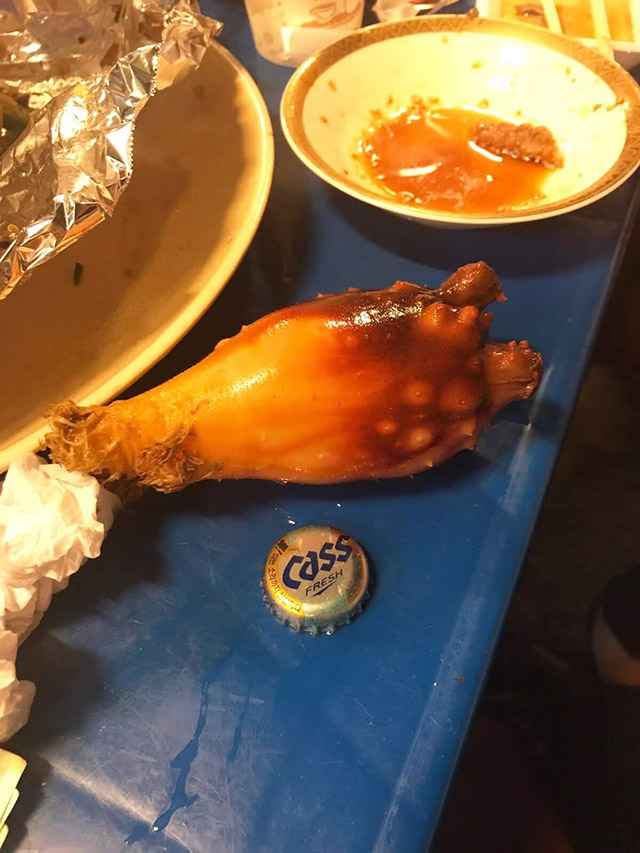
Pic by Rosie from Flying Fluskey
In South Korea, there is a wonderful tradition called seobiseu (service). In order to attain and maintain customers, some businesses will give you a few things on the house. Normally, these dishes are tasty and crowd-pleasing. Sometimes they bring you a sea pineapple! Despite the name, this is not a lovely juicy, but a kind of rock-dwelling sea creature. These squishy guys have no spine and as a result, when one is plopped in front of you, it has a sort of psychedelic wobble.
Once sliced, it looks like an inoffensive kind of lettuce in broth but it really doesn’t taste like one. The liquid is akin to seawater; extremely salty and cold. Then, the sea pineapple itself which turns to a gelatinous blob once bitten. There is no crunch, no chew, just a quick breaking down and a surprised swallow. The aftertaste is somewhat bitter, leading to greater consumption of any soju in the vicinity! It is held to a delicacy in some areas of Asia but it is a real challenge for the Western palate.
By Rosie from Flying Fluskey
Follow Rosie on Facebook at Flying Fluskey
8. Eating afterbirth of a cow in Thailand
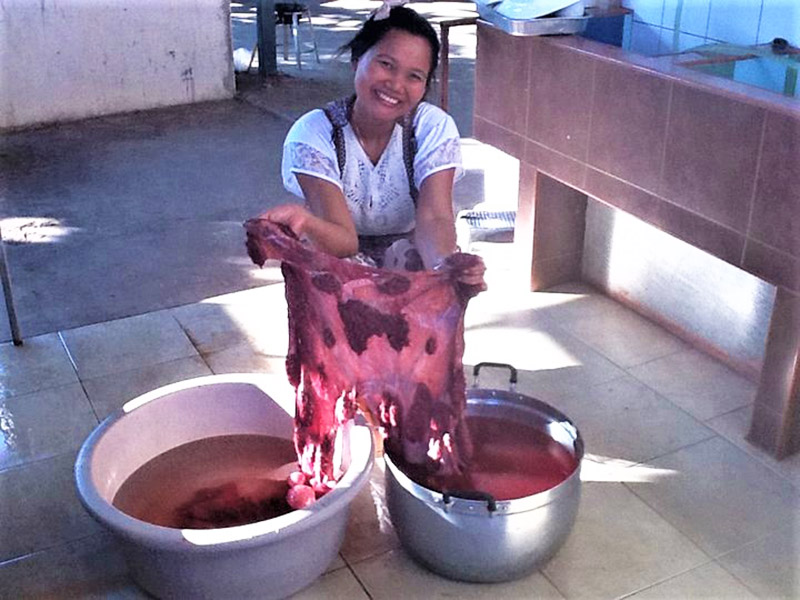
Pic by Theo from TripCrafting
Once you have seen all the temples, islands and crazy bars in Thailand, you should head to the Isaan. The northeastern part of Thailand usually flies very low under every tourist’s radar. But it is exactly here where you can have the craziest experience. After spending some time there and getting real close to the locals, they honoured me with a special treat.
After a cow gives birth, there is a huge placenta left and they simply cook it in some villages in the Isaan. It is not very common and therefore the whole neighbourhood came to have a taste. The whole placenta will be cooked and cut in smaller pieces. The meat, the broth and some vegetables are served with rice. The taste is only slightly unusual, resembling normal beef mostly. But knowing you are eating the placenta of a cow makes it a pretty interesting experience. One you can only have in the Isaan.
By Theo from TripCrafting
Follow Theo on Facebook at TripCrafting
9. Tinchuiche (river worms) in Huatulco, Mexico
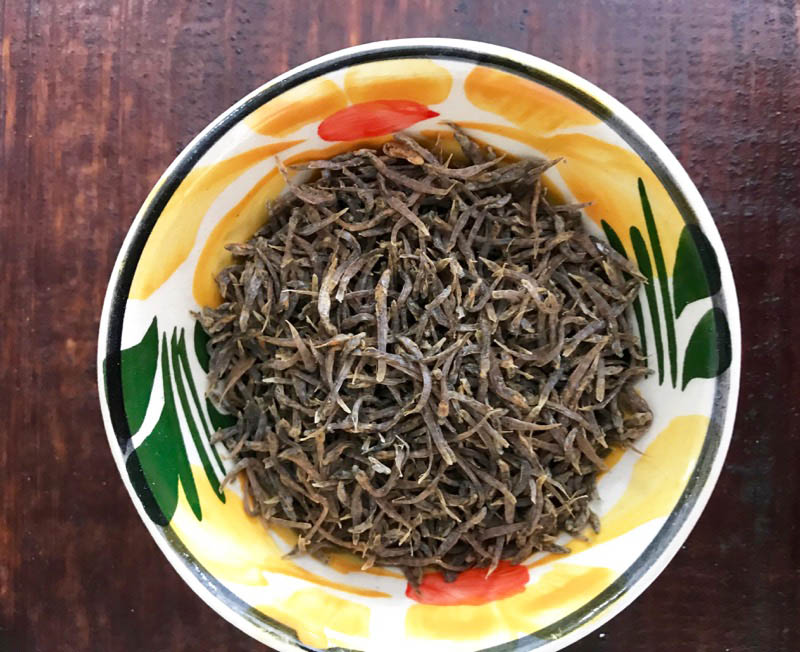
Pic by Michele from A Taste for Travel
One of the more unusual foods I’ve eaten also happened to be one of the most delicious. I was introduced to the regional ingredient known as tinchuiche during a cooking class at Chiles & Chocolate Cooking School in Huatulco, Mexico. The theme of the class I was participating in was “By the Sea” so we made some Pacific Coast shrimp, a shrimp mousse, ceviche ( with green apple!) and some regional Zapotec salsas. This is where the tinchuiche entered the picture.
Although I’m familiar with chapulines, the toasted, chile-tossed grasshoppers often added to salsas in the state of Oaxaca, I’d never heard of tinchuiche. The owner of the cooking school, Jane Bauer explained that the Zapotec word roughly translated into river snails or worms that had been dried and salted, transforming them into something akin to an anchovy.
I do like anchovies so was convinced to pop some into the salsa I was making in my molcajete (mortar and pestle). Later, as the participants in our cooking class sat down to enjoy our communal meal, I was surprised to discover that the river worm salsa tasted quite good, as long as I repeated “anchovy” with each bite.
By Michele from A Taste for Travel
Follow Michele on Facebook at A Taste for Travel
10. Intestines in Taipei, Taiwan
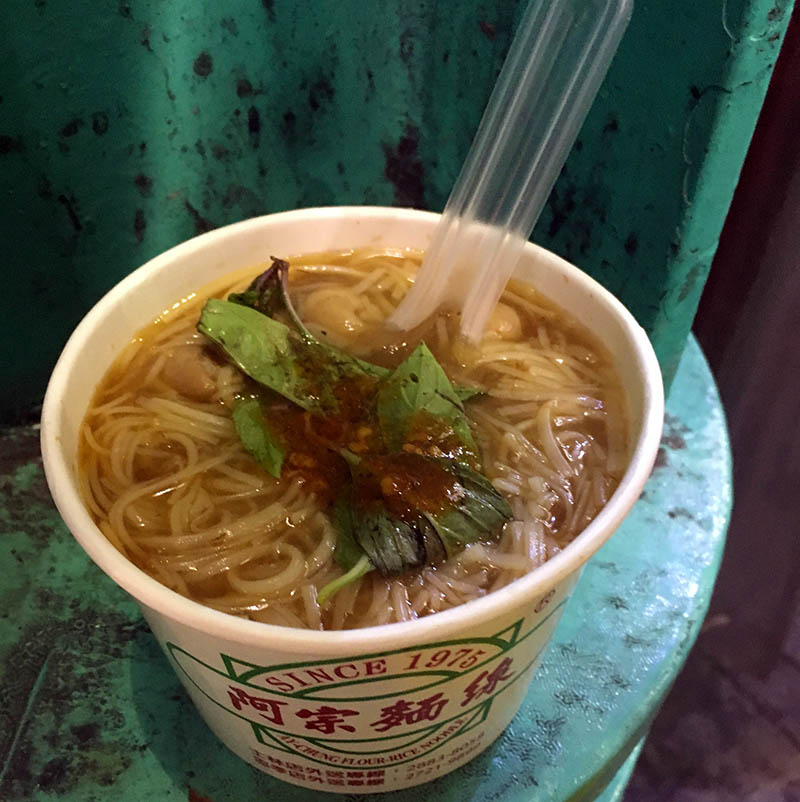
Pic by Helen from Differentville
I said I’d never do it. I said they were the one thing I’d never, ever eat – but one look at the 30+ people forming a snaking queue outside the famous ‘intestine noodle’ sellers of Ay-Chung Flour Rice Noodle in Taipei’s Ximending and I had to know what I was missing out on. Not to mention the fact that I was writing a post on Unusual Things to do in Taipei– and in my mind chowing down on bits of bowel definitely classed as odd!
A small pot of the gloopy noodles cost just 30NTD (about GBP £1) and so I figured at worst, I could subtly pop them in a nearby bin if they were as hideous as I imagined. I dowsed the bowl liberally in chilli oil and went and sat on one of the small plastic chairs outside all the shop.
All around me families were slurping up the noodles – nobody else looked squeamish. I started with the noodles themselves – not bad – and then, I went in. The intestines were cut into small chunks and upon first chew felt just like a mushroom or a clam – you could easily have told me that’s what it was and I would have believed you.
Admittedly, every time I ate a piece, I had to block out what it was in my brain before I swallowed, but I wolfed down the cupful. The pride I felt dropping an empty cup in the bin was weirdly immense! Next time I was in Taipei, I actively choose to add intestines to my dish – this time, they tasted good, like the fat on the edge of meat but chewy not goey, I also tried them in a soup in Japan. Not bad for something I said I’d never consume.
By Helen from Destination>Differentville
See Helen’s amazing pics on Instagram at Differentville
Related
Breakfasts in different cultures?
11. Norin in Uzbekistan
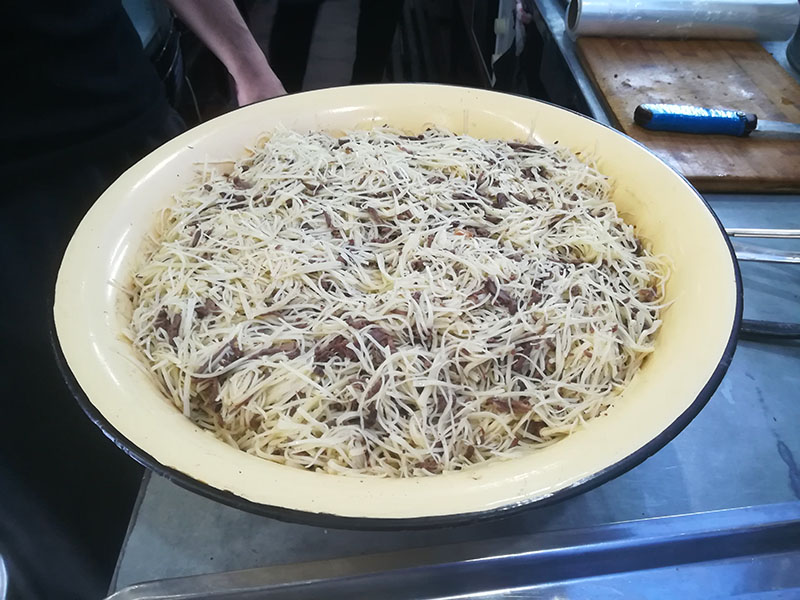
Pic by Ellis from Backpack Adventures
Horses have been an important part of life in central asia and it is therefore no surprise that horse meat is nothing strange in countries like Uzbekistan. On the Chorsu bazaar in Tashkent you will find a special section for horse meat next to the departments for chicken, sheep and beef.
Even though horse meat is rather common in the region, Uzbekistan has its own unique dish. Norin is made of cold handmade noodles with bits of horsemeat sausage. The recipe might be simple, but it is surpringly tasty and makes for a great sidedish or salad as part of your Uzbek meal.
Most restaurants that serve traditional Uzbek food have Norin on the menu and you can also find it in the bazaars and local teahouses. The traditional recipe uses horse meat sausages, but nowadays it can also be beef or mutton. The real Norin with horse meat has become a special dish for guests and festivities.
By Ellis from Backpack Adventures
See Ellis’s amazing pics on Instagram at Backpack Adventures
12. Scorpion in Thailand
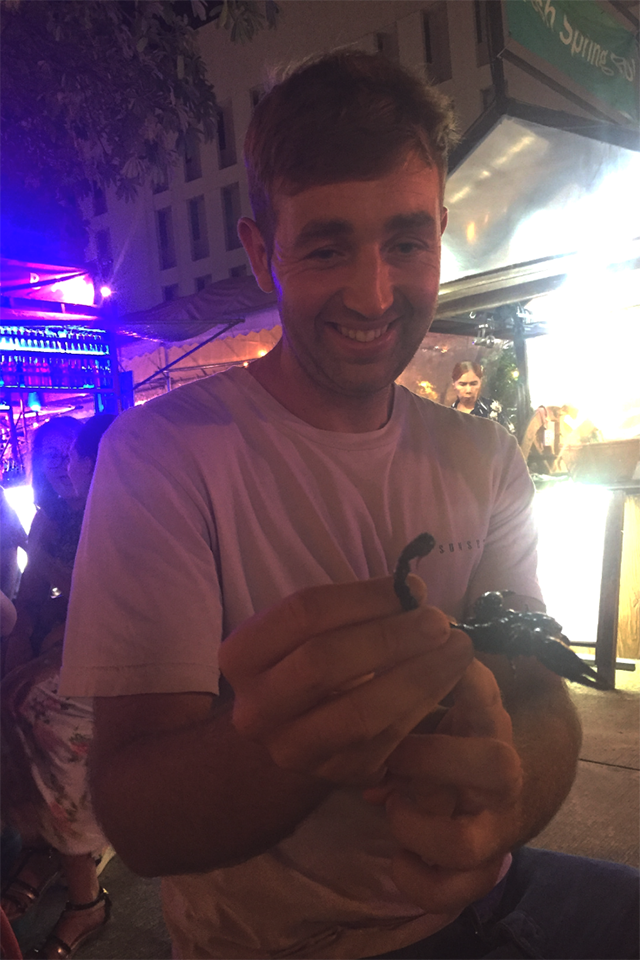
Pic by Louis from The Northern Boy
Have you ever tried some of the craziest foods in Thailand? I got to try (don’t know why I did it) a full cooked scorpion on my visit to Chiang Mai in Thailand.
We was on a food market in Chiang Mai having a few drinks when someone come up with the idea to try a cooked scorpion, after a few drinks I was like yeah why not?! After staring at it for 10-minutes I took the first bite for the group and to be fair it was not all that bad, it tasted like charcoal chicken. Mmmmm, no I wasn’t nice.
Cooked scorpion is actually a delicacy in Thailand, I would much rather have chicken to be honest. But that’s what travelling is all about, trying out the different foods on offer.
Where can I buy scorpion?
Scorpion is available on most food markets in Thailand, also there is always people walking around selling theme in the busy cities.
By Louis from The Northern Boy
Follow Louis on Instagram at The Northern Boy
13. Worm Omelet in Hanoi

Pic by Sue from Travel for Life Now
“What are those?” I asked.
Our chef for the cooking class, said “Worms.”
They were squiggling in water at the vendor’s sidewalk stall.
Then he said “Want to try a worm omelet? Reggie said “No!” just as fast as I said yes.
The vendor handed us a plate. It looked just like an omelet. I took a bite and it had a smokie flavor. I wouldn’t even have known that I was eating worms. Some people don’t like the texture, but it didn’t bother me. Reggie then took a bite and spat it out.
Ruoi Worms are sold by street vendors in the local markets and is considered a specialty in the Northern part of Vietnam. The worms are put into hot water to remove their tentacles and then fried with egg. It is mainly served in the fall when the worms can be caught and kept alive until cooked.
By Sue from Travel for Life Now
See Sue’s amazing pics on Instagram at Travel for Life Now
14. Fermented Shark in Iceland
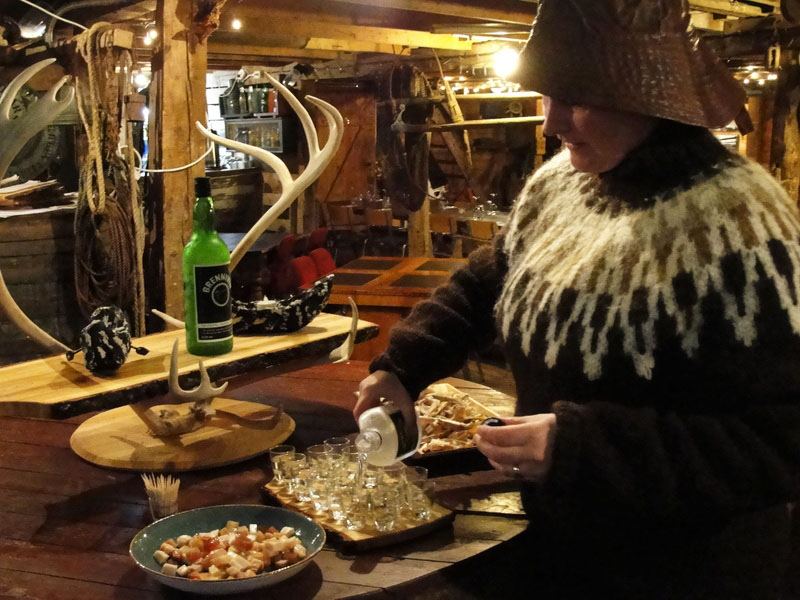
Pic by Carole from Travels with Carole
You’ll most likely hear plenty about fermented shark as you plan your trip to stay in Iceland. I have also heard the adjectives “aged,” “rotten,” and–my favorite–“putrid” used to describe this delicacy. Anthony Bourdain famously called it “the single worst, most disgusting and terrible tasting thing” he’d ever eaten. I ran into it in the remote Northeast area in the town of Eskifjordu at the rustically atmospheric Randulff’s sea-house/Randulfssjohus restaurant. Not wanting to miss this important cultural experience, I took a small piece of the stinky fish, put it on a cracker, and downed it with a shot of Brennivin liquor–an Icelandic schnapps that is made from fermented potatoes and flavored with caraway seeds (referred to as “firewater,” it is also known as “black death”). Actually, I didn’t down it but chewed it and then kept it in my mouth, afraid that if I did swallow it I would lose my cookies. I walked fast out to the deck, leaned over the side, dispensed with it, then went inside to dilute the taste with more of that Brennivin, which I liked enough to buy a souvenir bottle at the airport. But I hope never again to taste fermented shark.
By Carole from Travels with Carole
Check out Carole’s You Tube channel at Travels with Carole
15. Reindeer Sausage with a dip in Finland
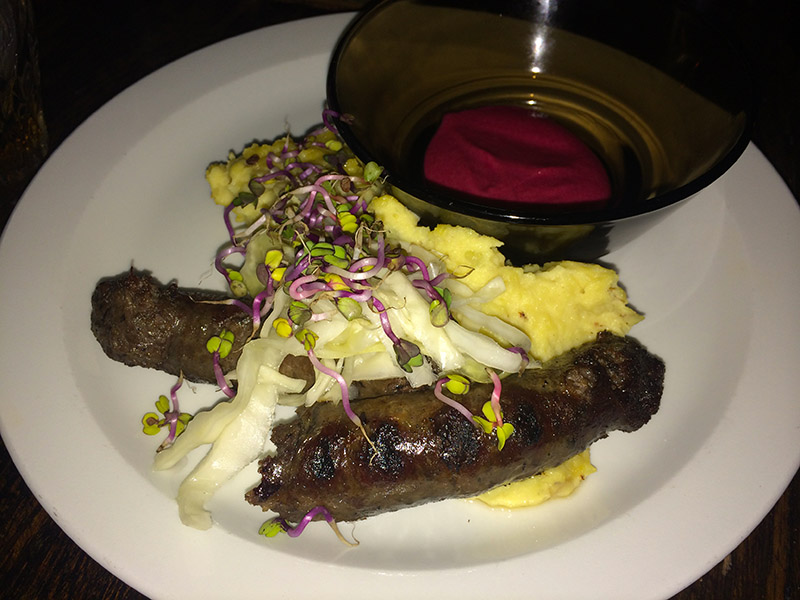
Pic by Sara from Our Kind of Crazy
Coming from the states, we were a bit unsure of eating Reindeer in another country. I mean, thinking of Rudolph made it a little hard to stomach. But, Americans eat deer, so it couldn’t be much different, right?
Reindeer was on the menu both in Iceland and in Finland, so we decided we would try it out in both places.
We were served reindeer once in Iceland, and a few times in Finland. We were able to try reindeer a couple different ways. We had reindeer sausage with a dip, which just tasted a bit gamey, and we had reindeer cut like a slice of ham on a sandwich, and by itself.
We asked some locals if it was a traditional cuisine, and they told us that it was actually quite expensive and typically eaten on special occasions and holidays. It’s pretty readily available at restaurants and in the store, so definitely one to try.
By Sara from Our Kind of Crazy
Follow Sara on Instagram at Our Kind of Crazy
16. Morcilla in Spain
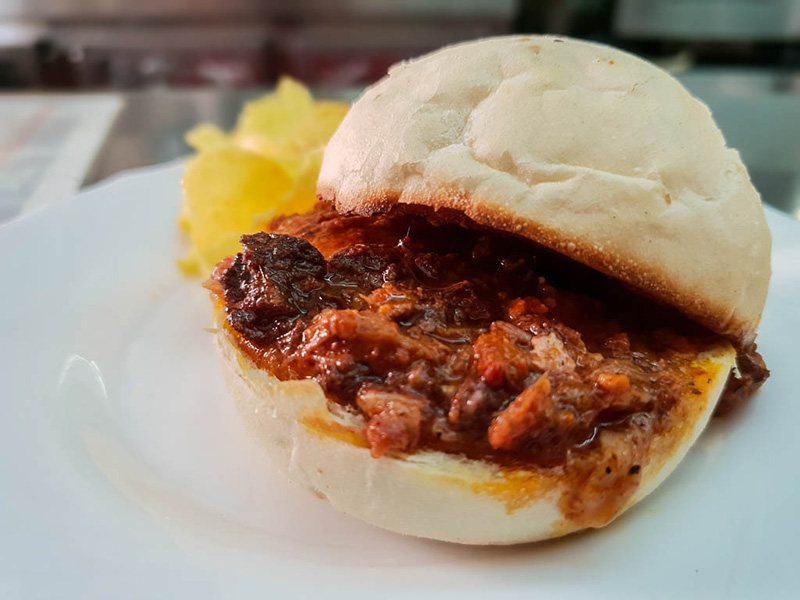
Pic by Amber from Foodie Destinations
Regardless of what it’s called, boudin noir in France, sanguinaccio in Italy or morcilla in Spain, they all have one common ingredient; animal blood.
In Spain, morcilla comes in many varieties and is served in many different ways. Made from pork blood, pork fat, onions, and spices, morcilla is generally formed into a typical sausage shape. Although it is possible to find it in other shapes and sizes.
Morcilla isn’t overly flavorful. More neutral in taste, there is a sweet or “dolce” version available from the Canary Islands. Morcilla can be grilled, fried, or roasted. It can be so soft that it is spread on a piece of fresh bread.
Variations include croquette de morcilla, which are battered and deep fried balls of morcilla. Or as small, tapas sized sandwiches called “pringas” where the morcilla is mixed in with yesterday’s pork meats.
It is possible to find both the croquettes de morcilla and the pringas at tapas bars in Seville and throughout Southern Spain. Morcilla sausages can be found throughout the country.
Don’t let the blood scare you off. When prepared well, morcilla is a delicious Spanish dish to experience.
By Amber from Foodie Destinations
Follow Amber on Twitter at Foodie Destinations
Related Post: Street Food in Europe
17. Wandou Liangfen (Pea Jelly) in Yunnan, China
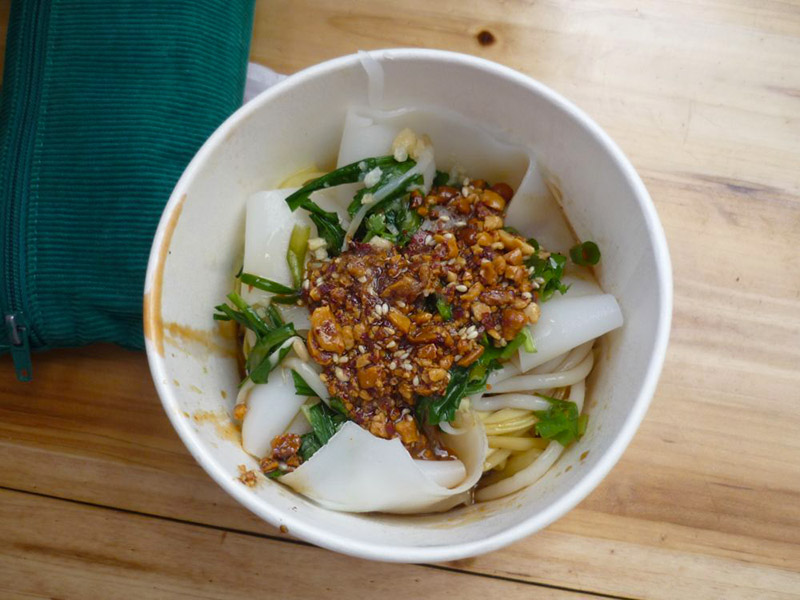
Pic by Wendy from The Nomadic Vegan
This Chinese name of this dish is wandou liangfen (豌豆凉粉), and in English it’s often translated as “pea jelly”. American readers, be warned that this is nothing like the jelly used to make peanut butter and jelly sandwiches! The consistency is more like jelly as it’s known in the UK, which Americans would call “Jell-O”. But this jelly is made from yellow split peas and is savory, not sweet.
To prepare this dish, the yellow split peas are blended with water and salt. This blended mixture is then cooked until it turns into a thick paste. Once the paste has cooled, it’s cut into chunks.
The first time I tasted wandou liangfen was in the small village of Xizhou near Er’hai Lake in Yunnan, China. The chunks of pea jelly were served in a bowl with rice noodles and topped with bean sprouts and a tangy peanut and chili sauce.
This is real, authentic Chinese food and hardly resembles anything served in Chinese restaurants in other countries. Pea jelly is one of many examples of the wholesome vegetarian and vegan Chinese dishes that are eaten by the rural population in China.
By Wendy from The Nomadic Vegan
Follow Wendy on Facebook at The Nomadic Vegan
18. Cow’s Head from a Firepit in Oman
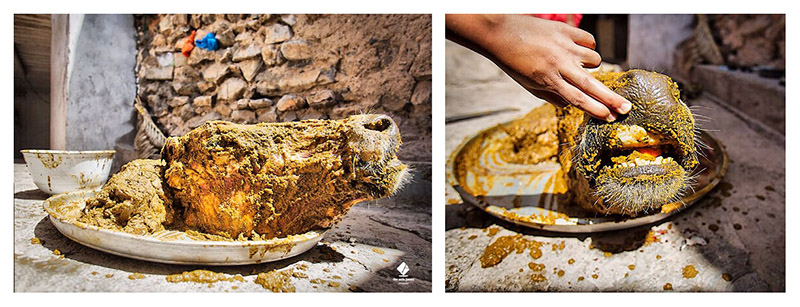
Pic by Ania from The Travelling Twins
Misfat Al Abriyeen is a tiny hill village, high in the Hajar Mountains of Oman. Every year to celebrate Eid al Fitr, the whole village participates in the tradition of Shuwa.
We arrived on the first day of the three-day feast. Palm logs had been burning for days in a vast pit within one of the village courtyards. Our hosts were at home, marinating the head of a steer they had killed that day.
The rest of the animal was being butchered in the house with axes and saws, and the stairwell was already festooned with hanging body parts.
These would later be frozen to keep for later in the year. The awful-skinned head was smeared in mud of oil and spices as it lay on the roof terrace. Then its jaws were stuffed with fruit. It was disgusting. There could be no way we would be eating that.
Our hosts wrapped it in palm fronds and then an old sack, and labelled it with a door hinge. They carried the gruesome bundle outside and cast it into the pit of charcoal and ashes along with all the other families’ shuwas, each differentiated with some metal item.
Two days later we came to the village again. Half a dozen young men were beating drums as the pit as uncovered and excavated by the men of a dozen or so families.
They retrieved the various sacks and returned to their houses to eat. Yes, of course, we joined in. The meat of our animal’s head was tender and delicious. The experience was unforgettable.
By Ania from The Travelling Twins
Follow Ania on Facebook at The Travelling Twins
19. Balut in Philippines
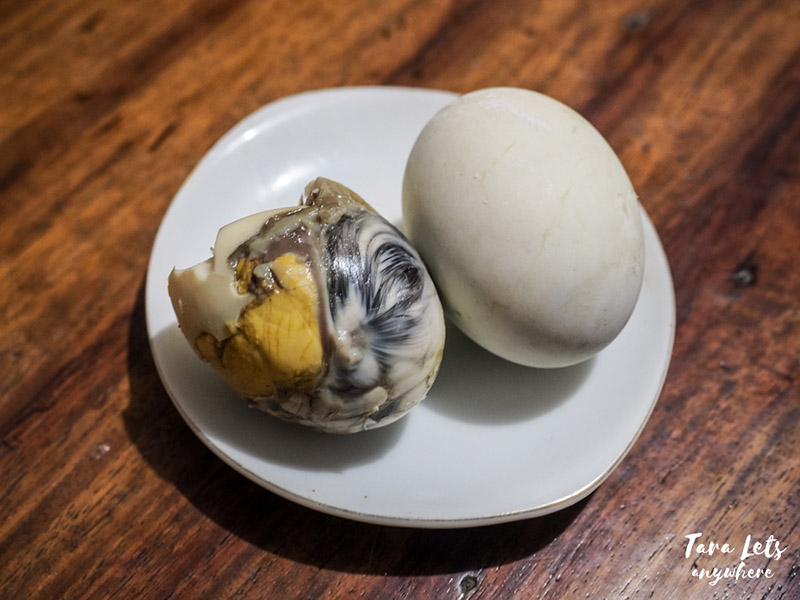
Pic by Katherine from Tara Lets Anywhere
Balut is a fertilized duck egg which is 2-3 weeks in development. It’s a popular street food in the Philippines and an infamous one all over the world due to the fact that the egg contains a semi-developed chick. The way to eat balut is to peel off the top portion and drink the broth. Then eat the chick and the yolk; the white part is tossed out. You can eat balut as is or add salt and/or vinegar depending on your taste preference.
Balut is sold at night by street vendors. It can also be found occasionally in malls. Select local restaurants also include balut as a main ingredient in their dishes (such as balut ala pobre).
Although a lot of people don’t find the idea of balut palatable, don’t easily dismiss it. It’s actually delicious and is one of the most authentic Filipino foods you should try in the Philippines.
By Katherine from Tara Lets Anywhere
Follow Katherine on Facebook at Tara Lets Anywhere
20. Fried Grasshoppers in Bangkok
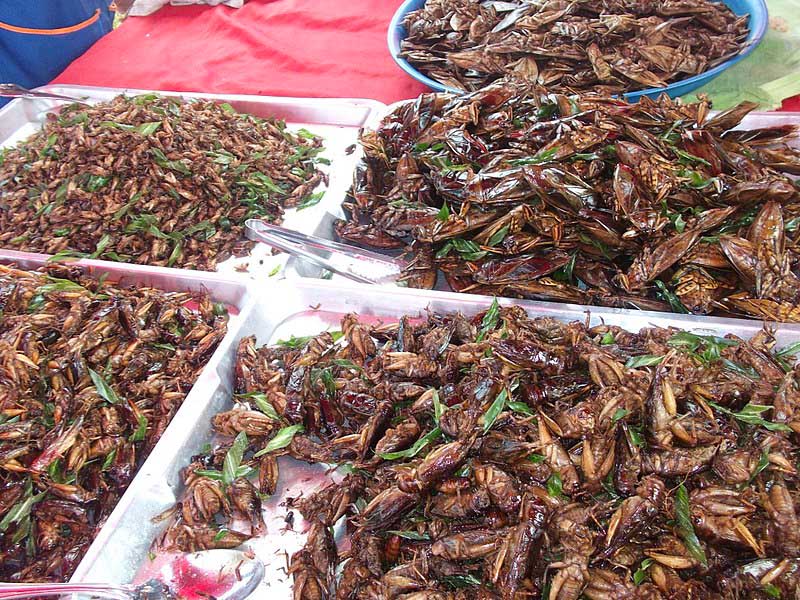
Pic by Vijinathkv from Wikimedia CC By SA 3.0
Thai cuisine is famous around the world. We all love the delicious curries and especially the famous pad thai noodle dish. But Thailand’s cuisine has got much more to offer. Thais love to eat ingredients we in the west would consider weird. Most soups come with some sort of guts or a scoop of fresh blood.
But the weirdest food I’ve tasted in Bangkok are fried grasshoppers. They can be found all around Thailand but most travelers will first encounter them on the famous Kao San Road in the heart of Bangkok.
The grasshoppers are fried and served as a whole including their long, thing and crunchy legs. After frying, they are covered with a thin layer of soy sauce, which is the main taste you will have when chewing on them.
The weirdest part about eating grasshoppers are the legs that will be all around your mouth after biting around on it. While it wasn’t a terrible snack, it wasn’t my favorite favorite Thai dish of all times either.
The food options get even crazier if you leave the capital of Thailand. Even if you just take a short day trip out of Bangkok, you will experience a different lifestyle and different food options. The further away from Bangkok, the more exotic the stuff on your plate gets.
By Mike from 197 Travel Stamps
Follow Mike on Facebook at 197 Travel Stamps
21. Durian in Thailand
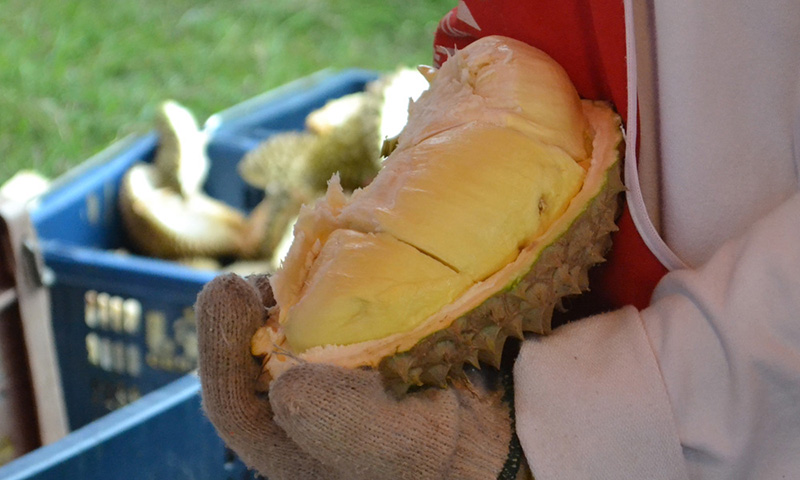
Pic by Allan from Live Less Ordinary
The Durian, known by many as the “stinky fruit”, has a renowned reputation in Southeast Asia where it is said to “taste like heaven, and smell like hell”.
And the smells are so off-putting to some that they have even been banned from hotels and public transport in many parts. But it is also said that if you like the smell then you’ll love the taste and this delightfully sweet fruit is also revered in equal portions.
So Durian season tends to start in April in Thailand, and continues through to around August, although there are some different strains, regions and seasons that differ (Mong Thong is the common durian in Thailand).
During this time durian will be found fresh at Thai street food stands as well as at the fresh markets throughout the entire Kingdom.
Durian is at its best when ripe and sweet, and almost custardy, and also goes great with desserts e.g. Durian Sticky Rice.
By Allan from Live Less Ordinary
Follow Allan on Facebook at Live Less Ordinary
22. Rabbit head in Chengdu, China
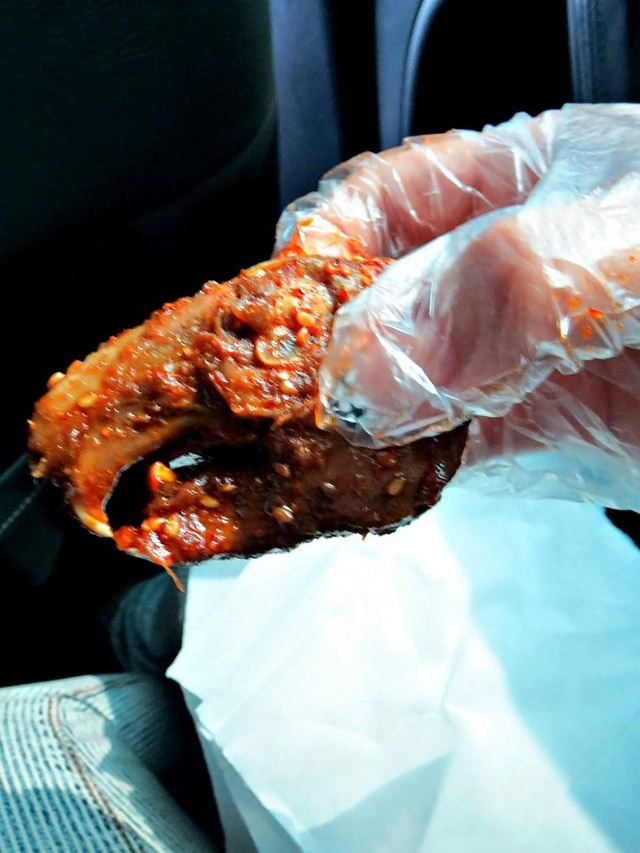
Pic by Daisy from Beyond my Border
Chengdu, China is known for its flavored rabbit heads. This delicacy is loved by many locals. Rabbit heads, like its name, are marinated rabbit skulls sold in a variety of flavors. Their true forms aren’t hidden, so one has to look past the appearance to enjoy the flavor. It really was quite a difficult task since the hollow-eye sockets and sharp teeth that remain on the skull are especially intimidating. The owner of the small shop told us to slurp on the head, as the meaty brains of these rabbit skulls are the best part of this delicacy.
With a pair of gloves on our hands and lots of mutual encouragement, my friend and I reluctantly chose a few flavors to try. Once we looked past the exterior outlook of these skulls, the flavor was pretty alright. But honestly, you really just get what you see, which is no more than slurping on a rabbit head.
Without a doubt, there are many things to do, and many cities to visit in China. I’m not sure whether rabbit heads are for everyone, but it was definitely worth the experience!
By Daisy from Beyond my Border
Follow Daisy on Facebook at Beyond my Border
23. Cuy on a stick in Peru
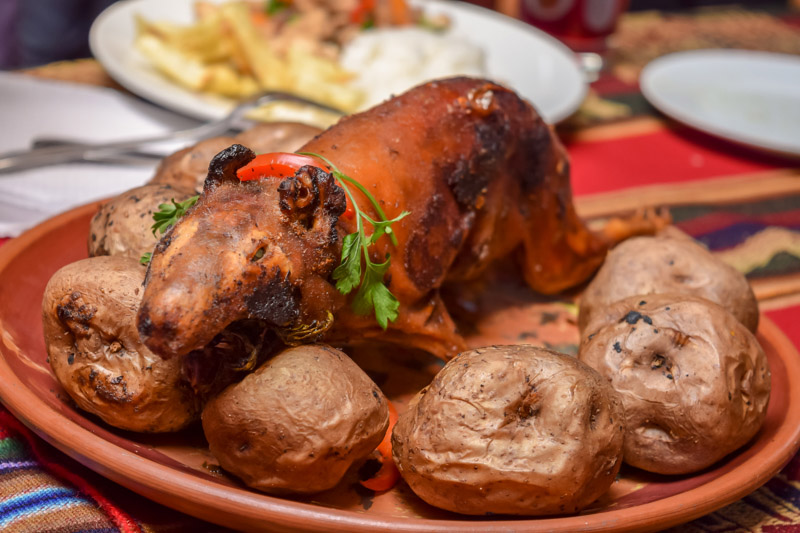
Pic by Dean from RoadTrips HQ
When you travel to Peru there are two unusual delicacies that really stand out: llama and cuy. Now most people will be willing to have a try of llama since it is quite similar to beef but a little more gamey.
The second stand out is cuy (pronounced coo-ee) which sounds really interesting by name alone, but when you find out it is Guinea Pig and it is usually presented as a whole roasted animal it can be quite confronting. Sure, you’ve eaten roast pig before, but a guinea pig? Really?
Cuy is served in restaurants all over Peru and some places also work like a drive through. Pull up out the front and waitresses bring Cuy on a stick for you to buy.
If you think the sight of someone’s pet coming to the table might be too much for you then asked for it to be served in pieces, like a chicken. And maybe ask them to leave the head in the kitchen.
Our Peruvian friend that escorted us to this local dining experience asked if it was OK for her to have the claws and feet. Apparently it is common for Pervians to use the little claws as toothpicks. That was a bit too far for me but I did enjoy the taste of Cuy.
By Dean from Roadtrips HQ
Follow Dean on Facebook at RoadTrips HQ
24. Modern Toilet restaurant in Taipei
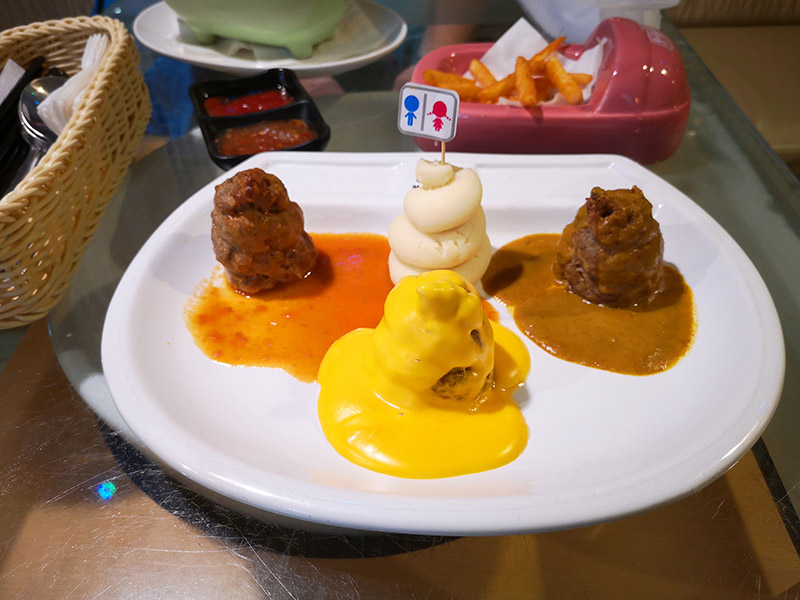
Pic by Samuel from Travelling Sam
When most people think about weird foods, their minds always jump to all number of scary insect on sticks!
However, it’s not always the food itself that is weird. There are restaurants out in the world that work their whole theme and style on being weird. My favourite by far, is the Modern Toilet restaurant in Taipei.
As you can imagine, everything in this venue pays homage to what your food usually ends up like. It can sound gross, but it’s amazing fun!
The outside of the restaurant is adorned with a giant toilet, the perfect announcement to let you know that you have arrived in the right place. All of the seats inside are, you guessed it, toilets!
Food, such as mashed potatoes, sausages and gravy, served in mini toilet bowls are the dishes of the day. You can even order your drinks in souvenir hospital urinals (don’t worry, they are brand new!) a really novel way to remember your trip to this fantastic venue.
The Modern toilet restaurant is based in Wanhua District in Taipei, on Xining Road, you definitely can’t miss it. My favourite dish was the curry served in a toilet, go wild and make a memory!
By Samuel from Travelling Sam
Follow Sam on Facebook at Travelling Sam
25. Giraffe meat in South Africa
This long necked marvelous animals is pretty uncommon in most of the countries in the world, which makes them pretty special. But in South Africa and other African countries, giraffes are common and it’s easy to spot them, which makes it legal to sell meat that is approved by the government institutions, because killing giraffes illegally and selling their meat is, of course, completely banned.
Giraffe meat can be found in some restaurants and hotels, but only in a few that are approved to sell this meat. On the past, when anyone could kill and harvest a giraffe it was commonly seen in the tables of lots of families, but now is more eaten by curious tourists.
One of the easiest places to find it is in the Carnivore Restaurant in Johannesburg, South Africa. It’s not offered every night, but if you are lucky you might get to have it. You can be even luckier if you ask the chefs or waiters.
About the taste, it’s an experience to just taste it because is completely different from any other meats you will try. Giraffes have a lot of muscles, so their meat is chewy and tough to eat, but if you like strong flavors it will be heaven to you.
By Alejandra from Universoviajero
See Alejandra’s amazing pics on Instagram at Universoviajero
**Please note: This post was written before the Giraffe went on the endangered species list. It is no longer available for human consumption.
26. Roasted Rats in Arunachal
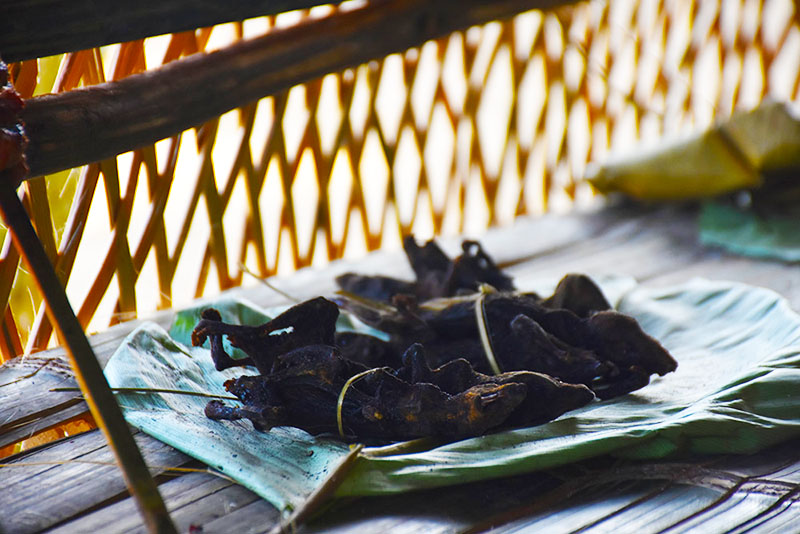
Pic by Amrita & Agni from Tale of 2 Backpackers
Our host ushered us in the common area where the Galo community sit together to socialize. Next is offered us one of their delicacies, roasted rats. I was a bit taken aback when the host offered me a place of roasted rats along with the rice beer. I had never tasted a rat before!
I had visited Basar in Arunachal Pradesh during the Basar Confluence, a 3 days cultural extravaganza celebrating the life and culture of the Galo tribes. Well, rat meat has been a protein-rich diet in many parts of India. For the Adi, Apatani and Galo tribes in Arunachal Pradesh, rat meat is always on the menu in any festival. These rats are smoke-dried and then roasted before serving. Sometimes, rat meat is also boiled with salt and chilli and eaten with vegetables. The most delicious part of the rats is the tails and legs.
I was a bit conscious at first. I have always known rats to be rodents. The host sensed my apprehension and he told me that the rats used for eating are specially bred. Without giving much a thought, I tasted the rats. Want to know how did they taste? Well, the taste was much like that of chicken, a little gamey. I did enjoy eating it with a glass of rice beer. After all, embracing culture and traditions is what travel teaches us.
By Amrita & Agni from Tale of 2 Backpackers
See Amrita & Agni’s amazing pics on Instagram at Tale of 2 Backpackers
27. Fried Silkworm in Assam
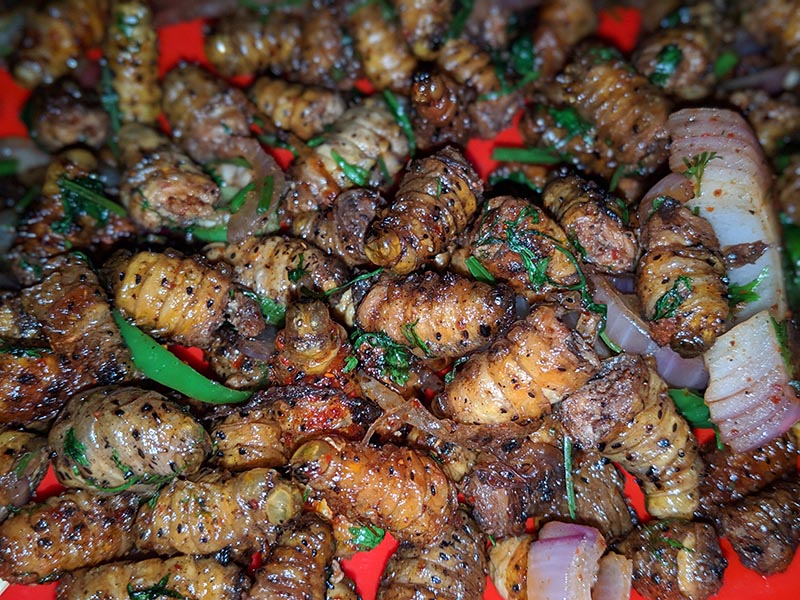
Pic by Amrita from Experience Northeast India
Travelling has introduced me to a lot of weird and interesting cuisine, insects being a part of them. Insects are delicacies in many parts of the world. When I visited Assam in Northeast India, I had for the first time tasted a lot of unique cuisines. It is here that I had also tasted silkworms.
Silkworms are mostly reared for the production of endi and muga silk in Assam and Meghalaya. The people as a part of their diet eat these worms. Mostly they stir fry the silkworms with onions and chillies and serve with some chutney. Sometimes these silkworms are also boiled and served. Silkworm is quite tasty, may be it has an acquired taste. But I found it quite good. It tastes like the egg yolk. If fried well, then it may also taste like prawns.
In most of the silk producing areas, silkworm pupa is boiled to extract the silk threads and the people eat the worms that are left behind. The silkworms have a rich source of protein and vitamins. No wonder they have become a delicacy in these parts of the world!
By Amrita from Experience Northeast India
See Amrita’s amazing pics on Instagram at Experience Northeast India
28. Basashi (Raw Horse Meat Sashimi) in Japan
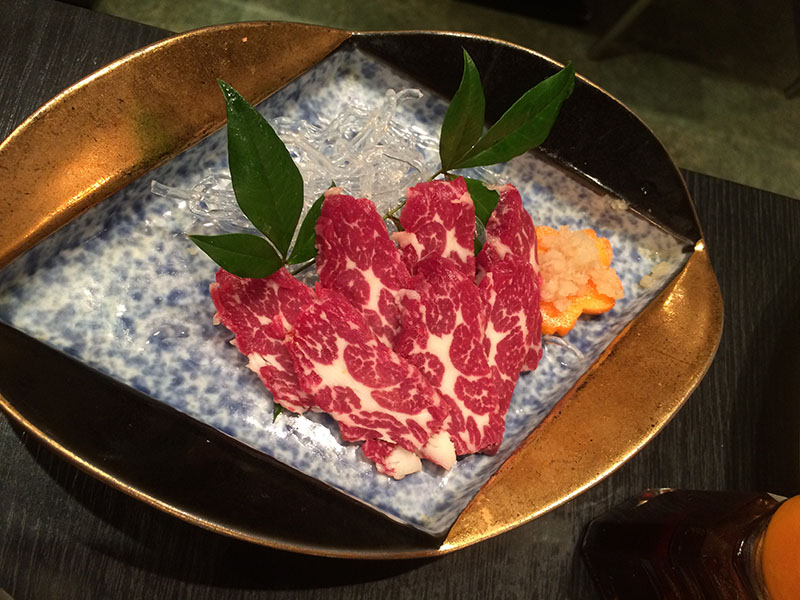
Pic by Lena from Nagoya is not boring
When visiting Japan it is important to try not only the famous dishes such as Sushi, Ramen or Yakitori it is also important to try the local specialties, such as Hitsumabushi in Nagoya or Takoyaki in Osaka. To get the full picture of amazing dishes Japan has to offer it is also important to challenge yourself now and again and try things you think are strange. Some will surely surprise you, and Basashi, raw horse meat Sashimi, might be one of the things that will.
When you hear raw meat for the first time you might think that can’t be delicious and is possibly dangerous to your health because of salmonella, and I suppose horse meat doesn’t sound so appealing eighter especially to people from North America or Europe where horse isn’t commonly eaten, but I encourage you to try Basashi anyways.
The raw meat is served in thin slices, like any other Sashimi in Japan. It is most often served with sesame oil and grated ginger a very flavorful combination. Basashi is especially famous in the area around Kumamoto in Kyushu but you can find it in some Izakaya, Japanese bars, all over the country. Have fun trying something different, you might like it!
By Lena from Nagoya is not boring
Follow Lena on Facebook at Nagoya is not boring
29. Flower-bred worms in France
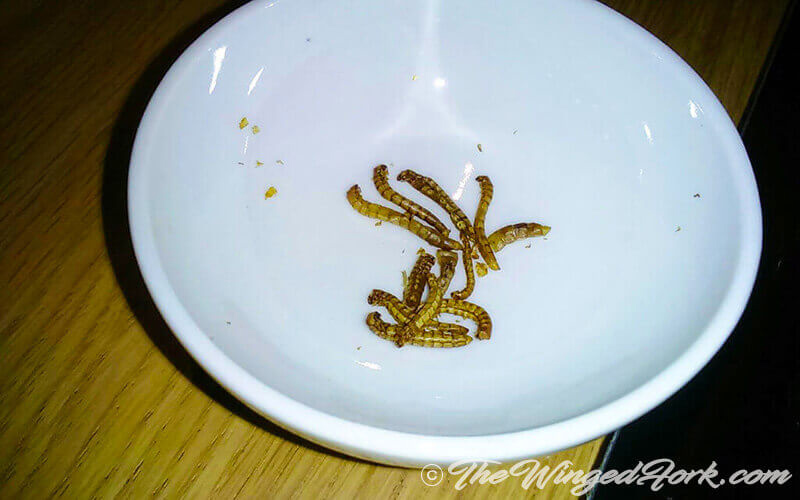
Worms, I ate worms! Me, the girl who’s scared of them so much that I’ll run into the other room if I see one, yeah, I ate them. Thankfully they were fried! And I watched my boyfriend (now ex-BF) eating a few of them first before I did. He seemed quite happy with them, so I gave them a try. They didn’t really have a taste, they were just crunchy, like the grillions that were being served with them.
These are flower-bred worms that are sold in the Futuroscope theme park in Poitiers, France. Yeah, they’re not normal food. But they are theme park delicacies. So if you’re even in France, head on to Futuroscope to give them a try. They’ll go right on that list with the snails, live oysters, frogs, horsemeat and other things you eat while in that land of food and flavor.
By Abby from TheWingedFork
Follow Abby on Twitter at TheWingedFork or join her Facebook group here.
30. Lahpet (fermented tea leaves salad) in Myanmar
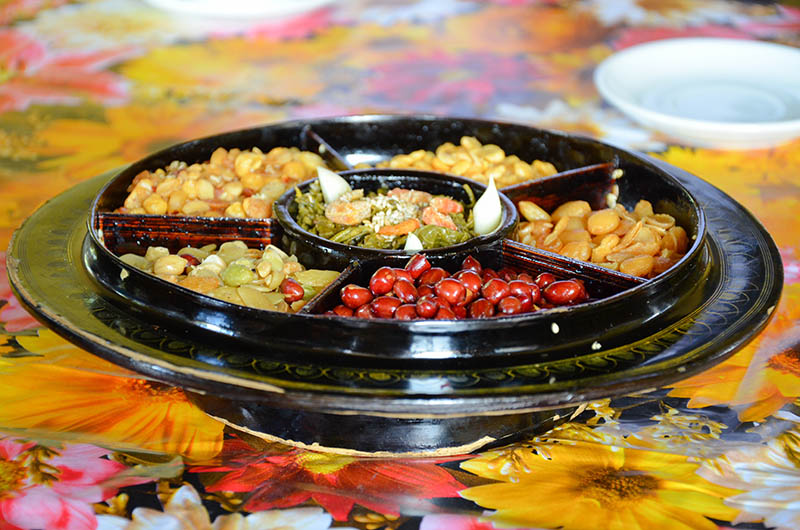
Pic by Teresa from Brogan Abroad
You may be wondering why you would eat tea instead of drinking it, and Myanmar is one of the few countries in the world that consumes tea in both ways. And no visit to Myanmar is complete without trying its cuisine. It is, in fact one of the top things to do in Myanmar.
Lahpet is a salad made of fermented or pickled tea leaves, unique to the region but with a few regional variations. I tried the A-hlu Lahpet or Mandalay Lahpet, and couldn’t get enough of it. It consists of fermented tea leaves with sesame oil, normally served in a central compartment surrounded by other compartments with crispy fried garlic, toasted sesame and peanuts, chickpeas, peas, fried shredded coconut and crushed shredded shrimp. It may not sound that good but once you try it you will be addicted to it, so get as much as you can while you can!
By Teresa from Brogan Abroad
See Teresa’s amazing pics on Instagram at Brogan Abroad
31. Duck Tongue in Taipei

I lived in Asia for just over 4 years and ate plenty of weird foods along the way and one of the weirdest was definitely a duck tongue. We found it at a night market in Taipei, Taiwan after a long night of perusing the markets. We found century eggs, stinky tofu, crazy skewers and so much more. In fact a large part of the trip was just so we could eat all kinds of crazy foods so when the vendor told us they had duck tongue I jumped at it! Okay maybe I didn’t. In fact I didn’t want to try it but my friend convinced me to give it a go. The tongue forked like a turkey wishbone but was chewy like octopus. It was boiled with a slight teriyaki flavor and reminded me slightly of an odd beef jerky, I wouldn’t say this was the most delicious food I’ve ever eaten but we laughed about it for a few days and experiences like that duck tongue are one of the reasons that I loved Taiwan.
By Mike from Live Travel Teach
Follow Mike on Instagram at LiveTravelTeach
32. Camel, Ostrich, and Crocodile in Kenya
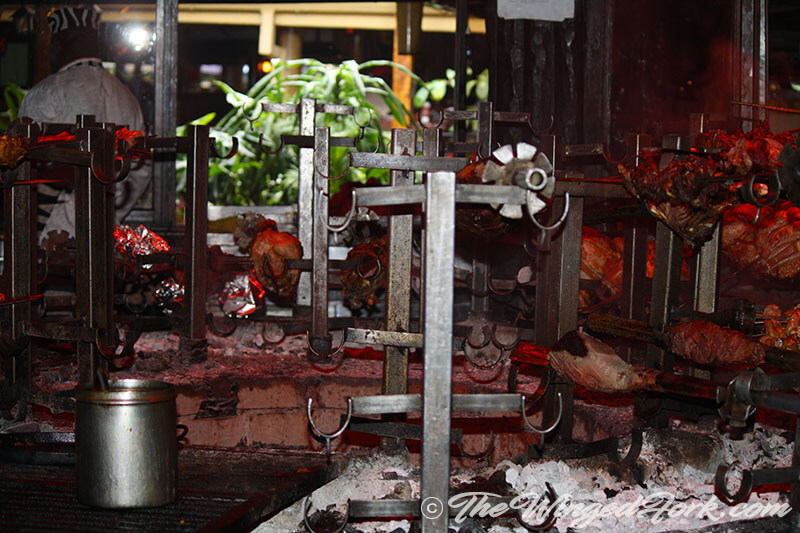
On one of my visits to Kenya, I had the pleasure of visiting the Carnivore restaurant in Nairobi. This place is a must-visit for meat lovers! The ‘Nyama Choma’ (Swahili for ‘roasted meat’) is awesome and not to be missed. It can be a bit overwhelming if you’re a vegetarian, so be prepared.
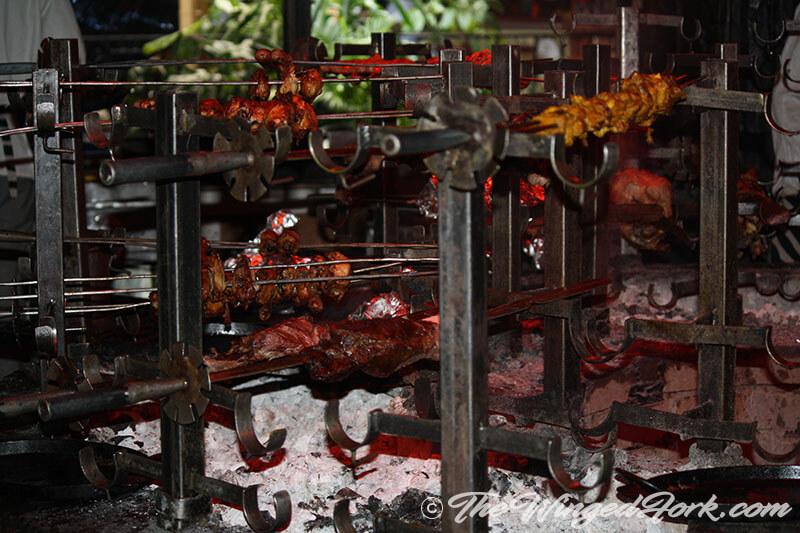
Once you enter, you are ushered to your table but not before passing through the oven pits where they are busy barbecuing the food. You can take pictures with the meat and also the chefs who are always smiling and welcoming the guests.
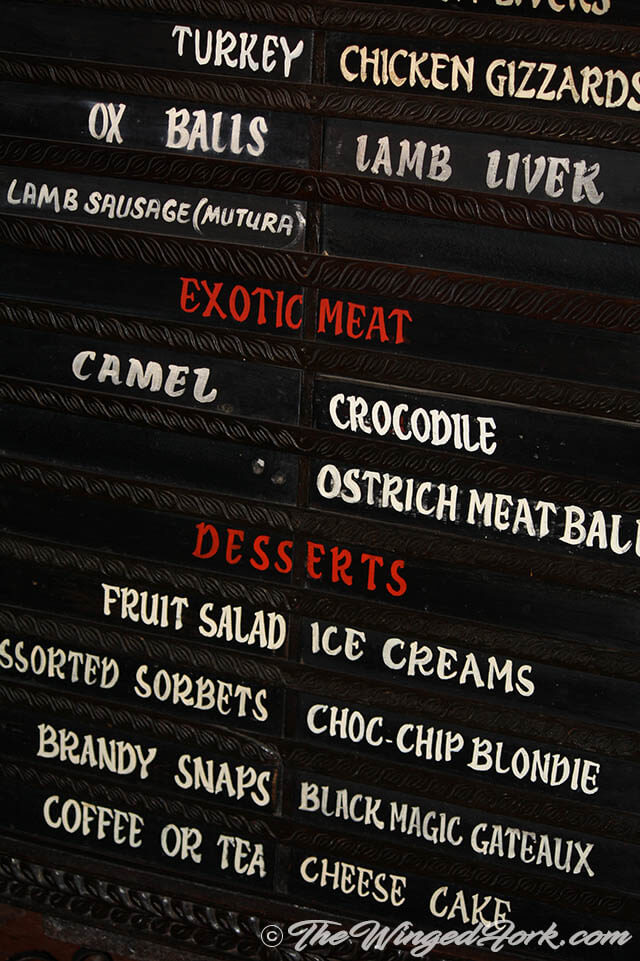
On the menu are a variety of meats, that are severed to you right off the grill. You have a choice of sauces as well as salads, to help with all the meat. Drinks are also available. You must try the local Dawa, this is my favorite.
Game meat is now not available though as these animals are on the wildlife protection list. But you have a choice of exotic meat like Camel, Crocodile, or Ostrich. The Crocodile tasted a bit like fish, the camel was kinda like beef, but tougher and quite chewy. Ostrich was like chicken or just ostrich.
The other regulars are chicken, lamb, pork, beef, and also who can forget Ox Balls. People seemed to be shy to try those though, so neither did I.. maybe the next time. At the top of the sauce tray is a carnivore flag, that you have to surrender once you are full and can’t have any more.
By Sarah from Abby’sHearth. Read the list of Sarah’s favorite parks in Kenya here.
33. Camel Biryani in Saudi Arabia
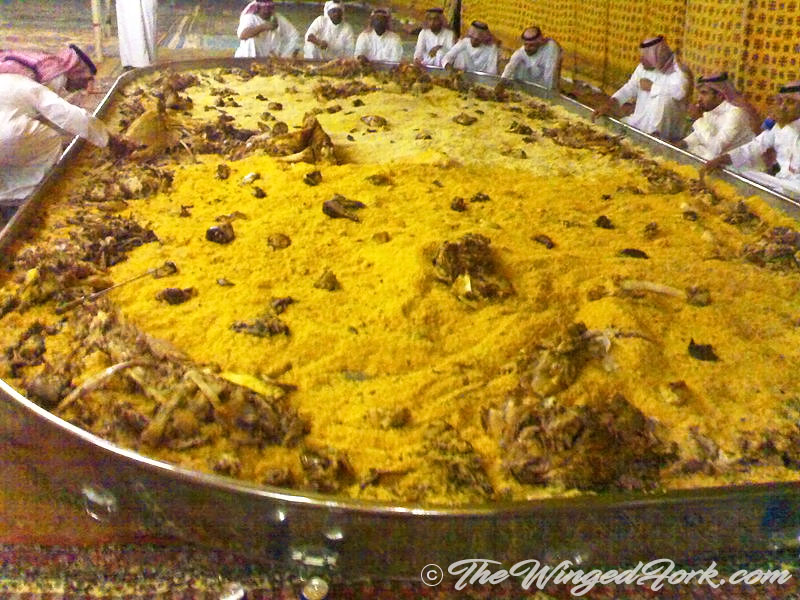
Pic by Jude from TheWingedFork/Abby’s Plate
Biryani is a unique combination of meat, rice and spices. The turks and moghuls invented the dish to ease up on preparation times whilst feeding their armies. I was privileged to eat a Saudi Biryani prepared with camel meat on a recent trip. It turned out into quite a feast.
By Jude, the recipe writing Uncle at Abby’s Plate
Okay, that’s it for the list of weird foods from around the world to eat. What did you find the worst and the best? The not-so-weird and the downright yucky? Comment and let us know.
PS. If you have something that you want to add to this list, ping me at abby@thewingedfork.com and I just might add it in. Toodles!
Other Foodie Posts You Might Like
- Where to eat in Taipei
- Must-see in the German city of Hamburg
- What to eat in Georgia
- All about the idli
- Where to eat in Chania, Greece

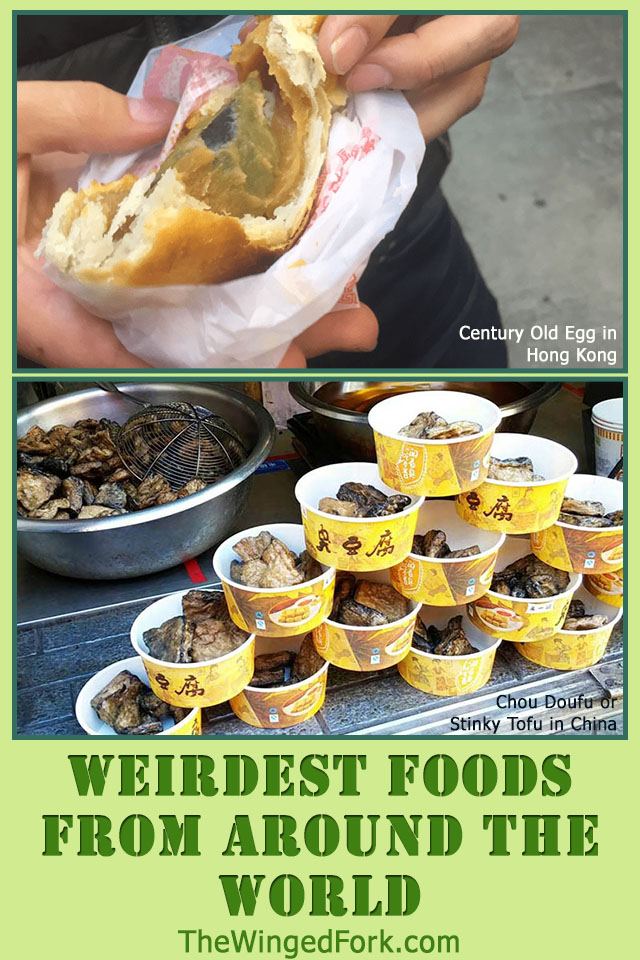
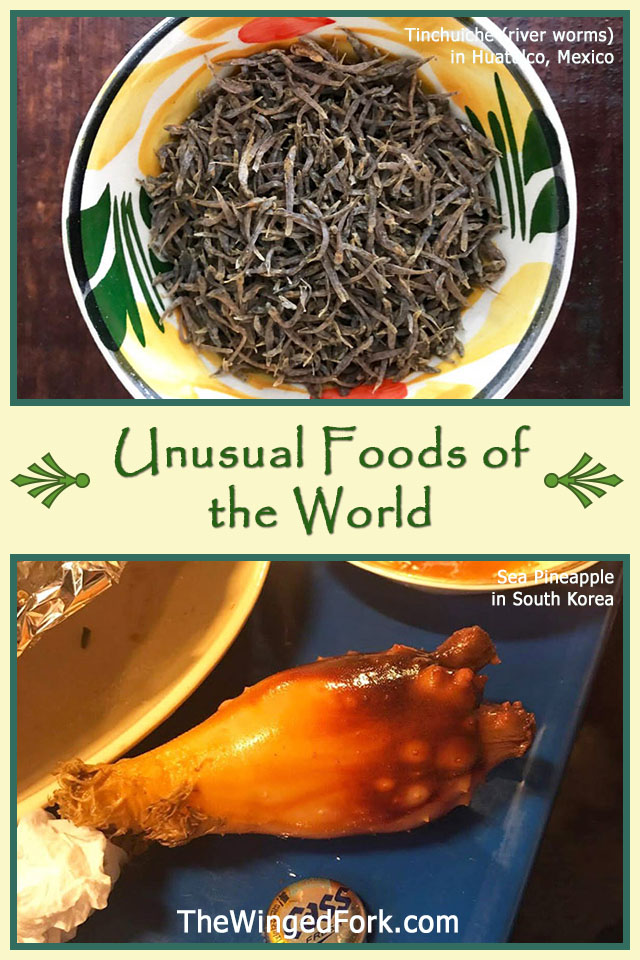
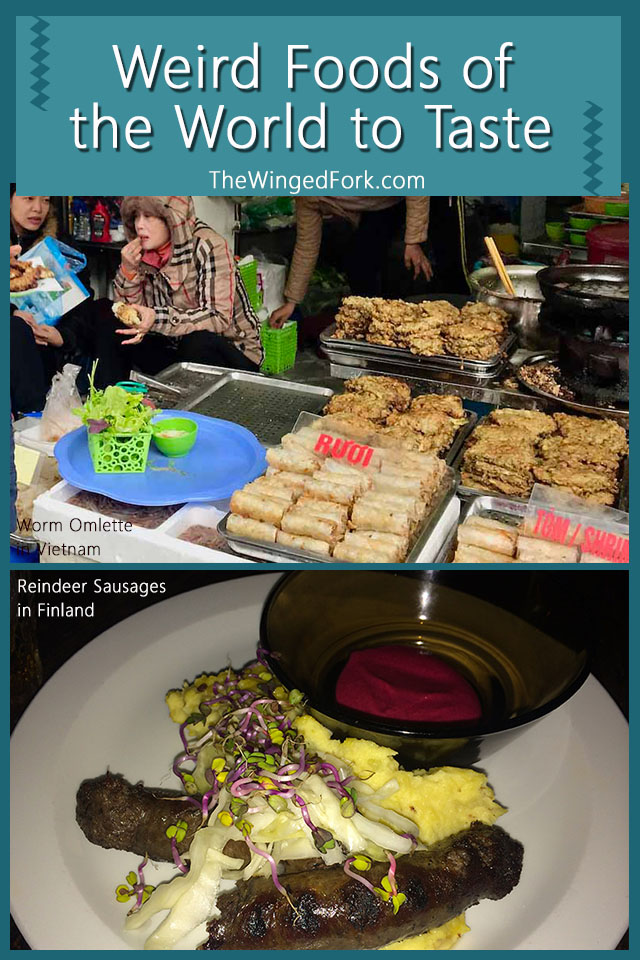
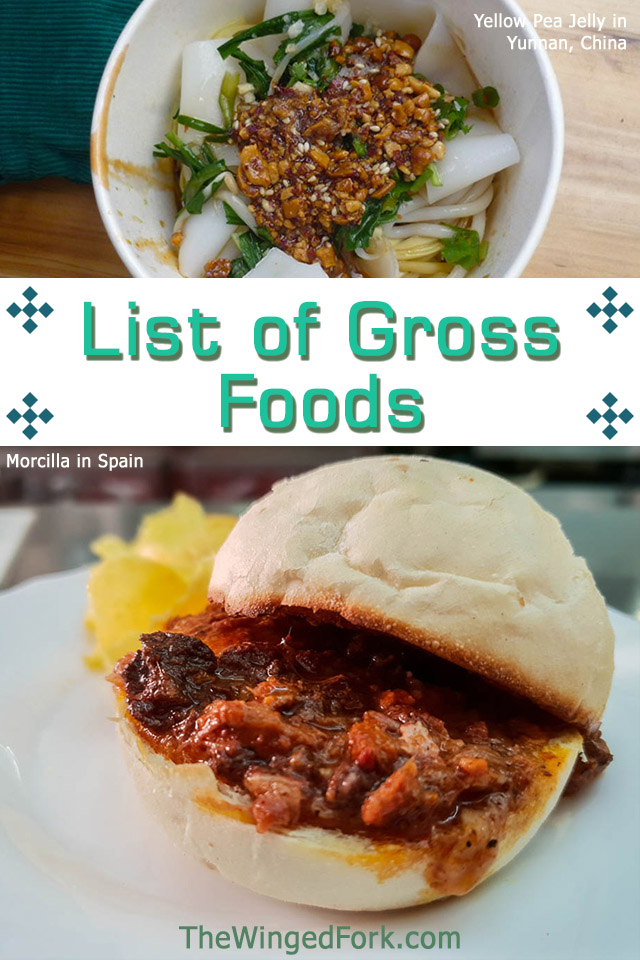

I’m an East Indian foodie and travel blogger from Bombay, India. I’ve travelled across parts of Europe and Asia, and love writing about my experiences with people and cultures. And naturally, I love food, wine, and travel, and have an endless bucket list of places to go to, and experiences I must blog about.
I also love baking and experimenting with food, with a little help from my family. If you must know, my favorite things are nice rainy days, the smell of cakes in the oven, playing in the snow, glasses of wine, and dark chocolate.
More info about me here!
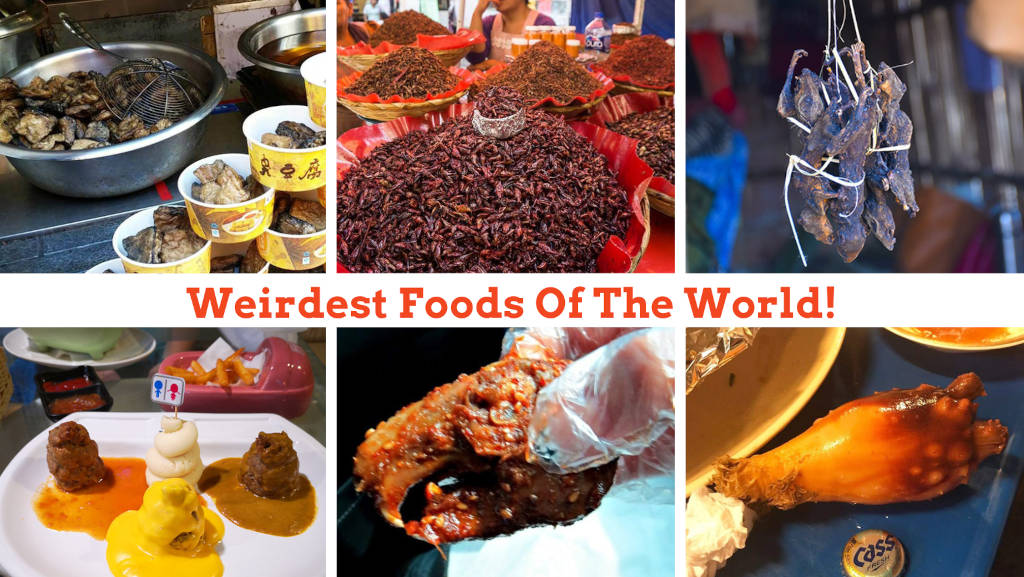

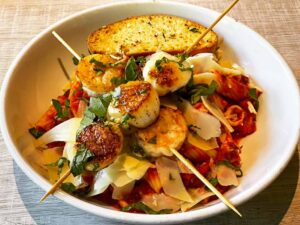
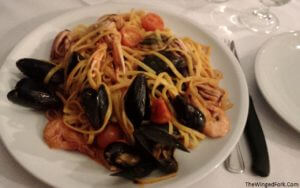
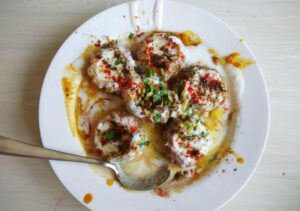

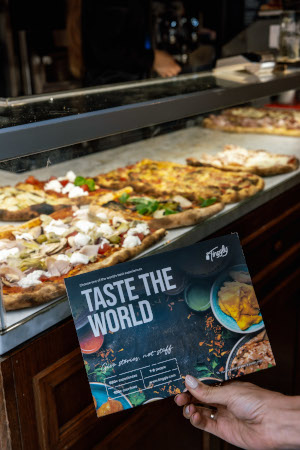
Thanks for sharing about these to try or not to try Weird Foods Of The World To Taste.
I am a foodie but reading this article reminds me that there are a variety of foods I haven’t tested.